The Cult Of The Code: Decoding Algorave & Its Future In South Asia
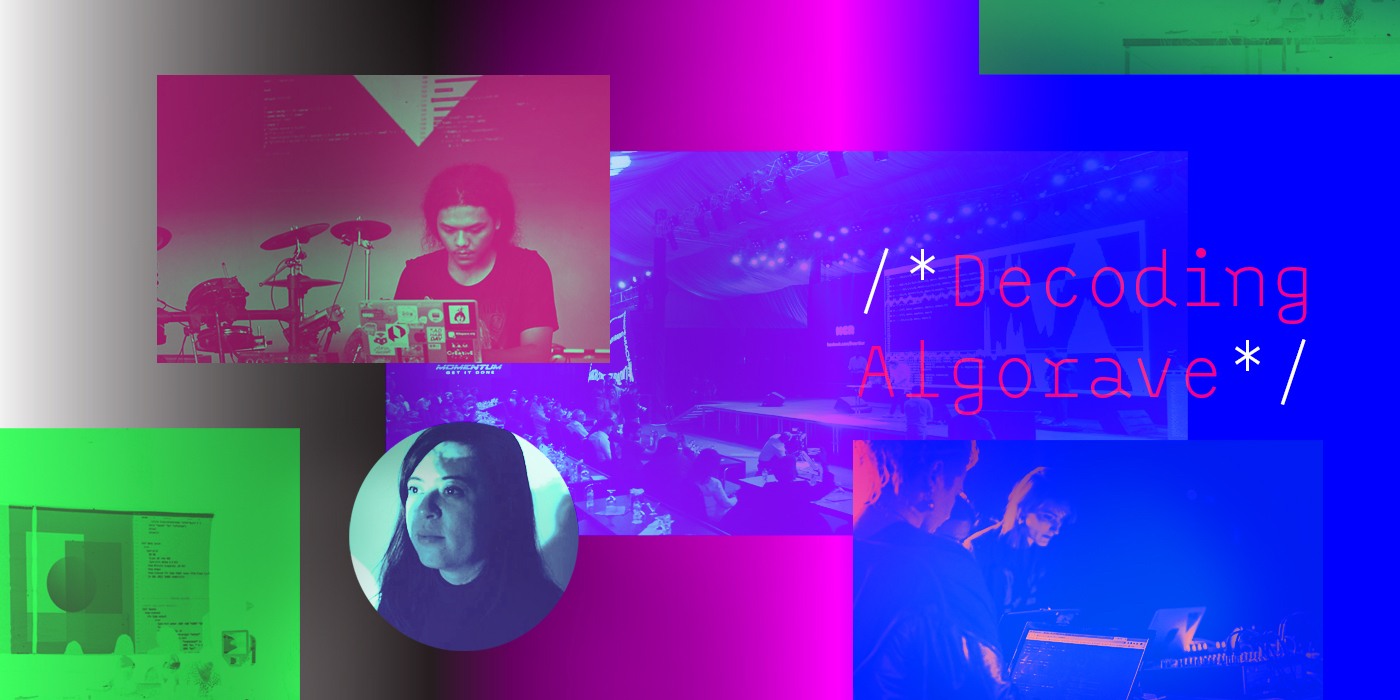
9 August 2021
As I make a beeline for my first Alograve (Pune, 2019), I recall a searing entry from the TOPLAP manifesto: Live coding is not about tools. Algorithms are thoughts. Chainsaws are tools. That's why algorithms are sometimes harder to notice than chainsaws.
Bridging the gap between pixels and physics, condensing decades of demo-parties, and reclaiming rave’s radical destiny, Algorave brought computer languages to the club at the turn of the century. A collective of computer hobbyists, originating in Sheffield, grew into a movement with a manifesto in 2009 that has since travelled to South Asia, reporting pockets of intense Algorave activity in Delhi, Karachi, Tokyo, Yogyakarta, and Haifa over the last decade.
At its futuristic core, Alograve is the stunning radical act of making code seen and heard. An Algoraver conducting the hypnotic, acousmatic movement of code on the wall, finds themselves at the centre of what can be qualified as a sensory multi-disciplinary practice, generating in real-time.
This is hardly surprising since the movement’s roots are more firmly situated in the museum and academic sectors than in the live music culture. In Japan, for example, where the scene is scattered but extremely prolific, live coders wear a lot of different hats - art faculty, media artists, IoT engineers, and web developers. Algorave India’s instigators Dhanya Pilo, Abhinay Khoparzi and Akash Sharma, similarly, have worked in film, design and sound research before turning to creative coding. Indonesia’s Rangga Purnama Aji identifies as a composer and video artist exploring human relations and automatism from a Javanese-Sundanese perspective, whereas part-Filipino artist Melody Loveless is a classically-trained percussionist now co-helming Brooklyn-based audiovisual collective Codie.
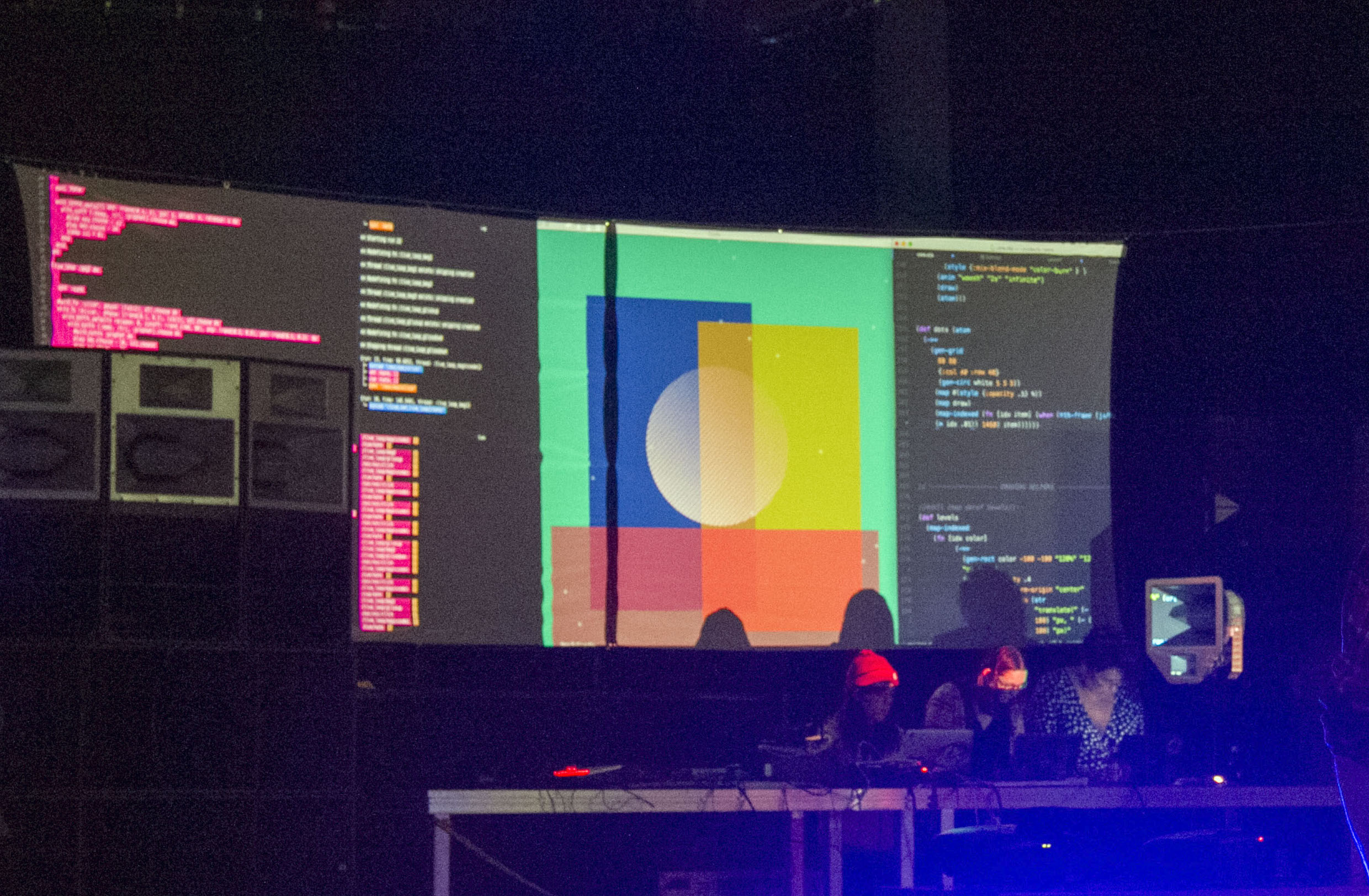
Audio-visual collective Codie in Spain, 2019
Playing by different codes
What connects all of them is the story of a community that opened them up to the possibilities of code, supported and encouraged them to ask for help, exchange their methods, and bring their personalities to the work. For many analog musicians, coding shifted the heavy-lifting of physically playing instruments to manoeuvring a set of scripts, offering an alternative to people with differing abilities and limitations.
As an abstract instrument, it further allowed them to create and model the system to their creative needs, making it easy to play alone, or with others if they preferred. With access to open-source programming systems like Tidal Cycles and Troop which come with detailed user manuals, free tutorials and active chat forums thanks to TOPLAP founder Alex McLean, Algorave became a handier, cheaper, go-to tool for many.
“I find it liberating as a musician to not be limited in any way by an instrument or a production software. I can pull out my laptop or a Raspberry Pi, and start typing out instructions to instantly generate all sorts of different sounds,” Jahazeb Safder, founder of Karachi Community Radio and host of Pakistan’s first Algorave, tells me. That was 2019. Today, along with Murtaza Tunio whose Twitter bio reads “renegade physicist from Berkeley, runaway from CERN”, Safder’s practice intergrates generative art into commercial projects.
While Safder finds algorithmic music precise and time-bound (“almost like classical music”), Japanese Algoraver Chiho Oka is smitten by the flexibility with which new media was co-opting code. “I wasn’t as influenced by pure live coding music practice as I was by art professor Akihiro Kubota who plays the piano with codes, or Elico Suzuki who uses a breadboard to patch in real-time!” Chiho admits in our email conversation, adding as an aside, “I was also tired of the 4/4 techno playing in Tokyo clubs and wanted to explore a new approach to dance music.”
Creating mostly with Python (for syntax) and SuperCollider (for synthesis), Chiho still returns to Tidal Cycles in the recording studio or at the Computer Music Parties she was hosting before the pandemic. Constantly stretching the limits of automating human interaction, her recent set programmed the MacOS to react sonically to keyboard/trackpad inputs at the virtual No Bounds Festival, organised on TOPLAP’s 18th anniversary this February.

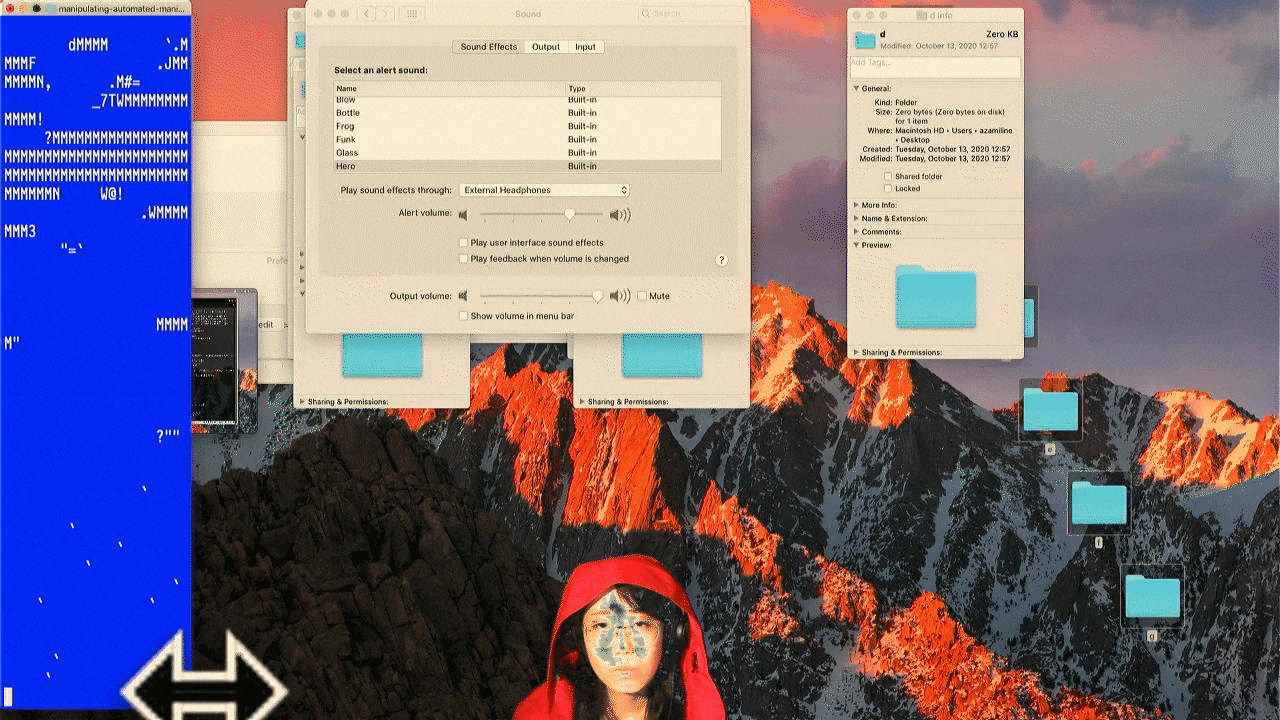
 Chiho Oka
Chiho Oka
Generative visual artist Anushka Trivedi agrees that creative coding has the power to transform, even heal, our relationship with tech. Having performed her first set virtually this year, she says, “What fascinates me about drawing with code are the possibilities of meta-design. It challenges you to consider more than just the aesthetics of your work because the focus isn’t on the final image but on designing the process that leads to it.”
At Codie, Melody and her creative partner, Sarah Groff build on this argument but warn against half measures. “Making things more ‘scrutable’ makes them more representative, Sarah points out, adding, “But it’s important not just to show how things work but also reconfigure the meanings we’ve already assigned to things. With more women or more non-white people working on these technologies, we won’t escape from the biased and the unjust — we’ll have just diversified it.”
“So I think the most revolutionary thread in Algorave and the TOPLAP manifesto is the idea that meaning is provisional and investigable and questionable. You need openness to get there, but openness is not enough.”
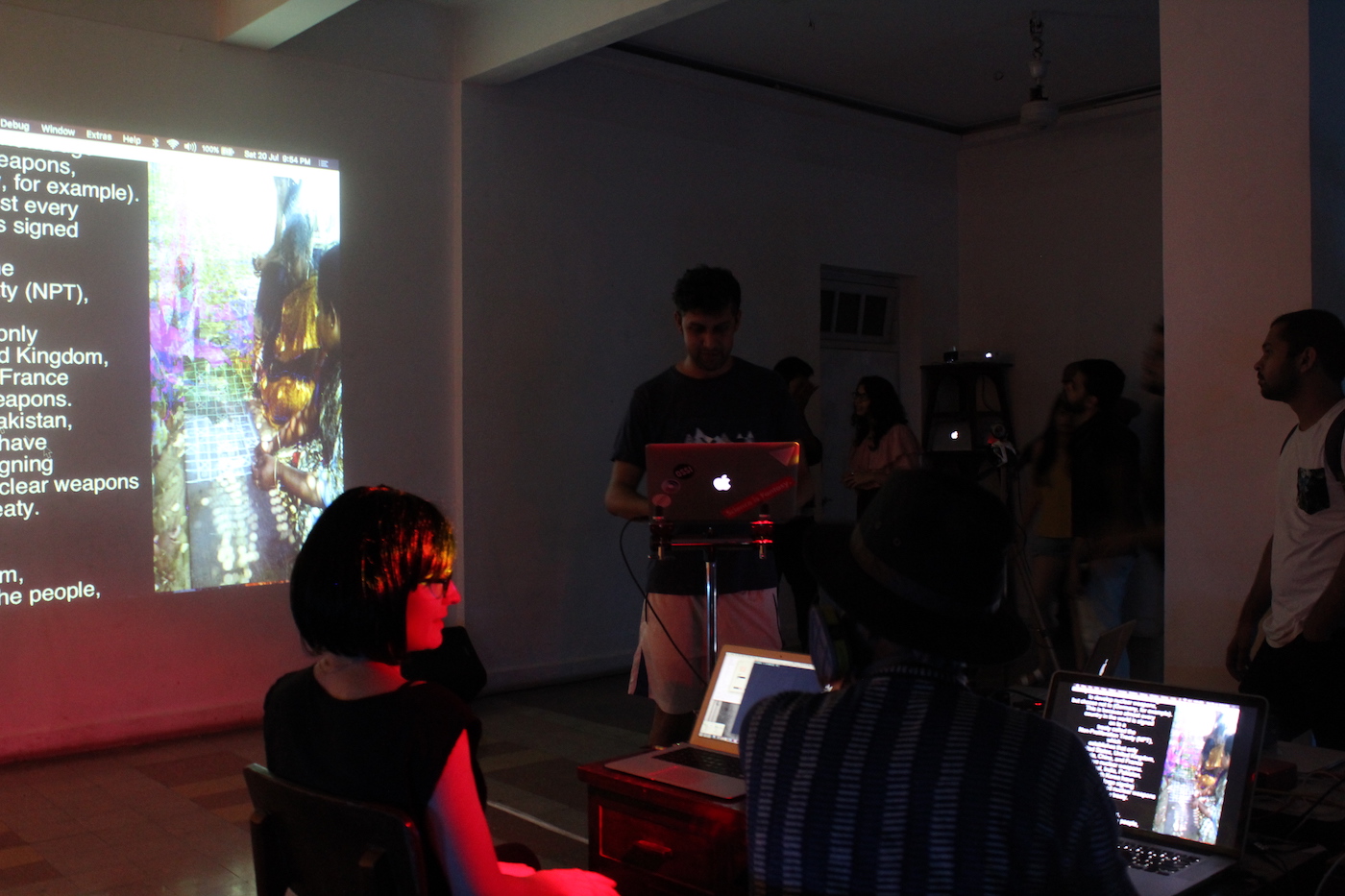 Sarah Bahr, Abhinay Khoparzi and Akash Sharma at Algorave 2019 (Pune, India)
Sarah Bahr, Abhinay Khoparzi and Akash Sharma at Algorave 2019 (Pune, India)
Unlike most industries retroactively fixing representation issues within their ranks, conversations of diversity and inclusion are embedded in Algorave’s code. “The scene is more diverse than pure tech, video synthesis, maybe even new media art,” Sarah attests but “still white, male, cis-het” and not exactly the prototype for a cyberfeminist future. “Algorave Tokyo is like a men's college of technology,” Oka also complains while noting the contributions of western coders Renick Bell and Carl Stone in Japan.
Within the Algorave movement, there is however an active and concerted push to ensure representative event line-ups and to cultivate and kindle interest, build capacities, and bring more early career artists, particularly women and non-binary folks of colour onboard. Many instigators like Alexandra Cardenas, Miriam Khatoon and Mynah Marie, among the first wave of Algoravers in the global south, share a sense of commitment to this cause - organising workshops, facilitating discussions, responding to FAQs online, creating safe virtual spaces and collaborating with newcomers. Gatekeeping is strictly frowned upon, Abhinay Khoparzi tells me, and instead of a centralised regulatory body, the regional groups implement TOPLAP’s inclusivity codes on a case-by-case basis. “Every community, understanding the endemic situation better, looks into their own”.
Mainframing diversity
While many of Alograve’s women pioneers, like Lizzie Wilson and Dr. Shelly Knotts developed a knack for music production while earning their STEM degrees, others like Lucy Cheesman knew only a handful of functions when they got started. Many of them, like Sarah, Ambika Joshi (from India) and Maria Astaya (from Indonesia), are young mothers challenging the exilic notions of domestic rituals and care labour with flourishing careers in coding and art.
“Three years ago when I was pregnant, I began noodling on a simple coding framework called p5js. The rest is history!” Ambika, a creative technologist, tells me. As the co-founder of generative literature collective dra.ft, her foray into Algorave helped build on dra.ft’s poetry projects. “We got a glimpse of what’s possible in co-po-jam [dra.ft’s AI-poetry event] where collaborative poetry in the Zoom chat collided with algorithmic music and visuals and so much more” she recalls.
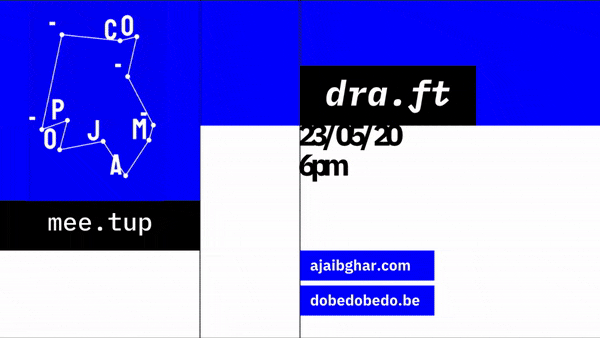
A glimpse into co-po-jam, computational poetry events by dra.ft
This is certainly a much-evolved scene from the one I had encountered in 2019.
The first time Khoparzi and I had spoken after the Pune Algorave, we commiserated briefly on the dearth of women representing the movement from India. Besides Berlin artist Sarah Bahr, I remember Becky Fernandes (Raia) being the only other woman at the event. A month later, Delhi’s Banana House created history, hosting the country’s first all-women Algorave with Ambika and Nanditi Khilnani of dra.ft, Mohna Singh aka Febby Momma, and Timeblur Studio’s Natasha Singh in the lineup among others.
Khoparzi who helmed it thanks promoters like Himanshu Bablani for their support and faith, also beaming at the fact that many of the artists who played the gig are now designing and offering courses to enthuse public interest in coding. For instance, Ambika hosts and streams byte-size coding sessions (once a week), often with just 5-10 people. “Attendance is quite diverse, from experienced coders to artists and designers. I have regular participants too, including a design faculty who is 60!” she tells me.
In Indonesia, Rangga is a leading force, constantly trying to make Algoraves more accessible. He is known for taking newcomers under his wing, showing them the rungs, in the same way he’d been inducted into the global circuit by Argentinian coder Iris Saladino.
“Before our first collaboration, I remember Rangga sharing videos of them setting up in a backyard, with folks hanging tapestries. It reminded me so much of the Buenos Aires suburbs, where there’s never enough budget for elegance, so people recreated traditional symbols from folklore,” Iris tells me. By then, she had been corralling a lot of coders on CLiC, a live coding git-hub, first by networking with central cities with nice spaces and decent technical equipment, eventually connecting with coders in the global north, which increased visibility on Latin American initiatives and helped them access funds and support systems.
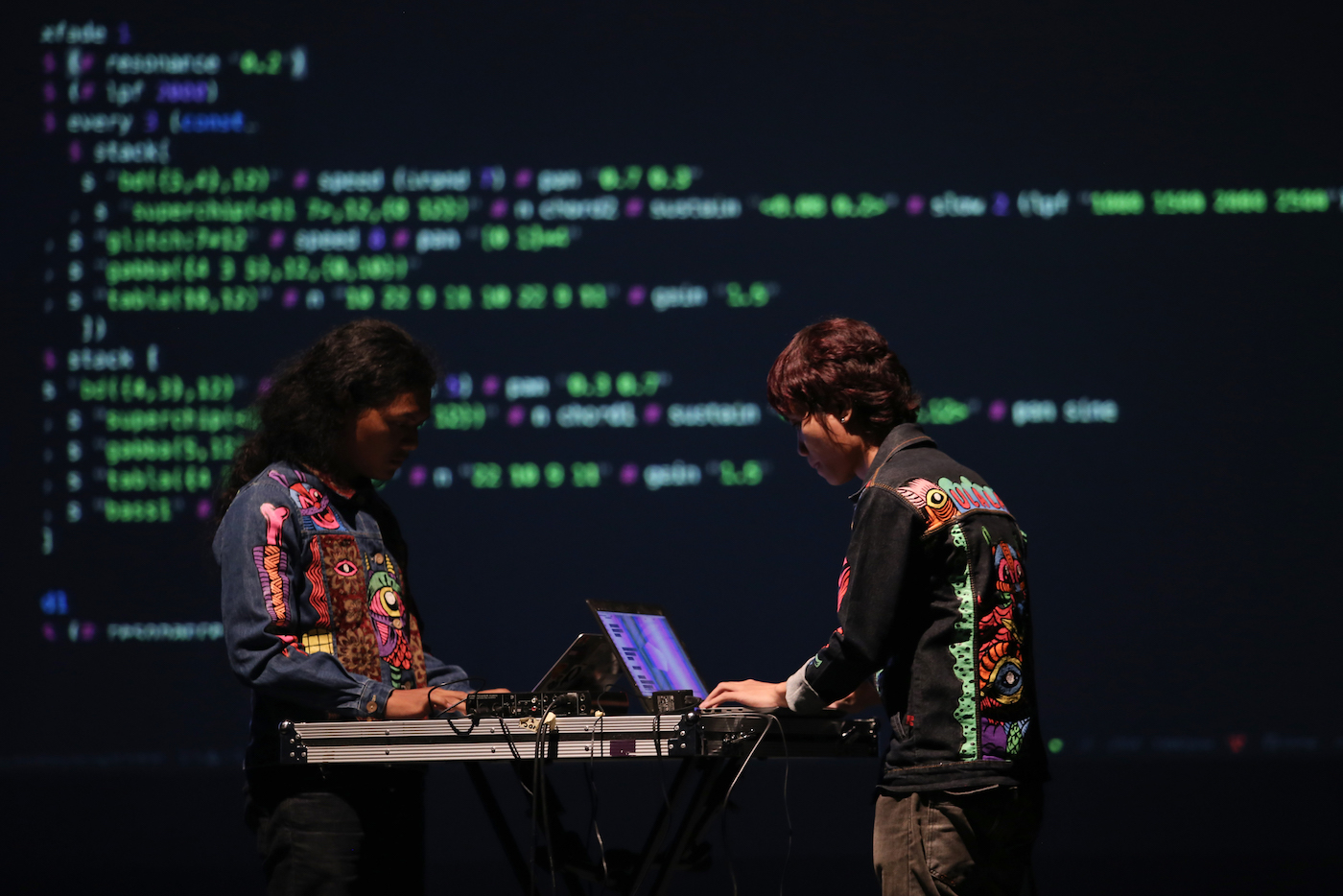 Rangga Purnama with live coder Clarentino Triadi at ARTJOG MMXIX 2019 / Photo by Klitih Bunyi
Rangga Purnama with live coder Clarentino Triadi at ARTJOG MMXIX 2019 / Photo by Klitih Bunyi
Today, Rangga collaborates frequently with cellist and contemporary music programmer Maria Aristya (as BASASAE), and as ANTI/SUPER TEMPORAL with curator Ignatia Nilu, and artist Atasia Ishii. The latter hails from a traditional arts background and it was only during the pandemic, which brought with it a spate of virtual Algoraves, that she began taking lessons on FoxDot from Rangga. This kind of a knowledge exchange- and open learning-based ecosystem feeds the whole debate about the scene’s commercial viability, which affects the extent to which coding enthusiasts can “professionally” practice their passion, especially in the emerging economies of South Asia.
Not strictly business
“It’s very hard to make anything commercial out of Algorave itself,” Sarah says right off the bat. Melody recommends getting flexible day jobs without letting them define you. “I know this exemplifies peak-Millennial burnout culture but if you’re meant to make art, you’ll do it no matter what.”
Lifting the ‘shrinking commons’ lid, Anushka argues, “For me, code isn’t a means to generate revenue but a non-capitalistic method of expression. The idea of coding as relaxation - without any clear set of goals unlike software development - really resonates with me.” Melody adds to this radical notion of production and labour, saying, “I’m definitely a fan of free and open-source technologies and do my best to advocate/support their creators. If technologies like Sonic Pi or Hydra weren’t free and open-source, I’m not sure I would’ve tried them.”
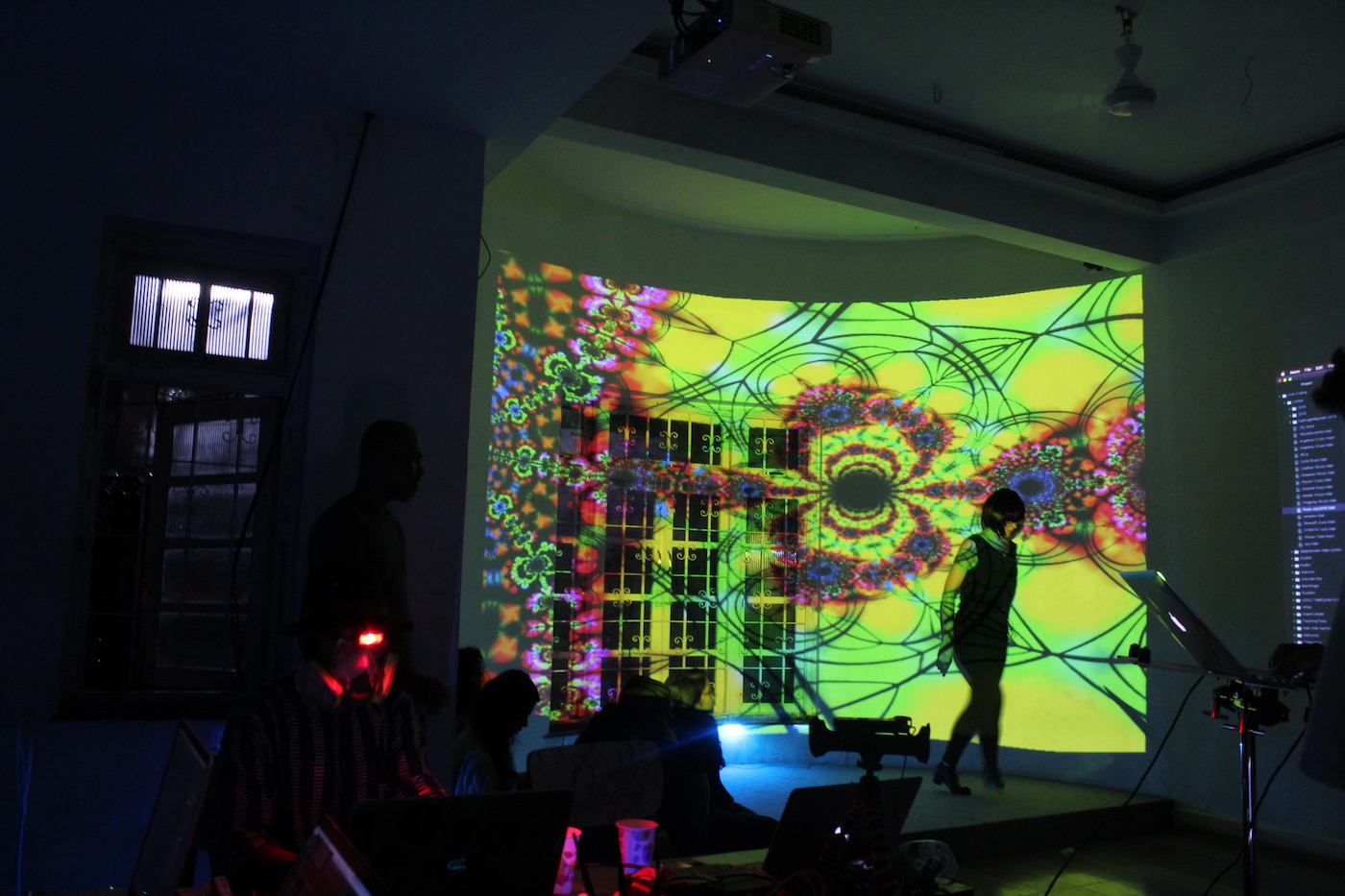 At Algorave Pune (2019), Sarah Bahr demonstrates how sensors pick up dancers’ movement and feed it to algorithms to interpret and manipulate sound accordingly
At Algorave Pune (2019), Sarah Bahr demonstrates how sensors pick up dancers’ movement and feed it to algorithms to interpret and manipulate sound accordingly
“On the other hand, lately, I can’t help but wonder about the long-term sustainability of such projects. So much more could be created if these creators got more support. The idealist in me hopes that someday, there is a structure in place, to give back to the culture in a fair, quantifiable way,” she adds.
Safder has a different strategy for this conundrum. Through his practice as a self-taught programmer and entrepreneur, he strives to integrate generative art into commercial work to generate some revenue, although he often finds that brands and producers rarely invest in something they find “outlandish”.
It was nearly a decade after his first tryst with the New York coding scene that Safder brought Algorave home as part of a tech conference, in partnership with his Karachi Community Radio and a few friends. It created some buzz but the scene continues to be in its infancy with most coders working in silos. Shouting-out The Nest I/O's work to incubate and support Pakistani women in tech, Safder stresses how any living and breathing scene requires an inclusive community with patrons who are genuinely invested. “For generative work to thrive, we also need to validate, contextualise and educate different kinds of audiences,” he adds. “It’s something that we’re trying to do at KCR Studios, by helping conceptualise experimental work in new and interesting ways so it's palatable for commercial projects.”
His creative partner Murtaza suggests setting up a platform where generative art can be exhibited and sold in commodifiable ways, to address the visibility-viability gap, also advocating for a “hackerspace” to celebrate electronic creativity in all forms. “The only support I’ve seen in Pakistan so far is from a handful of individuals and communities like KCR,” he tells me.
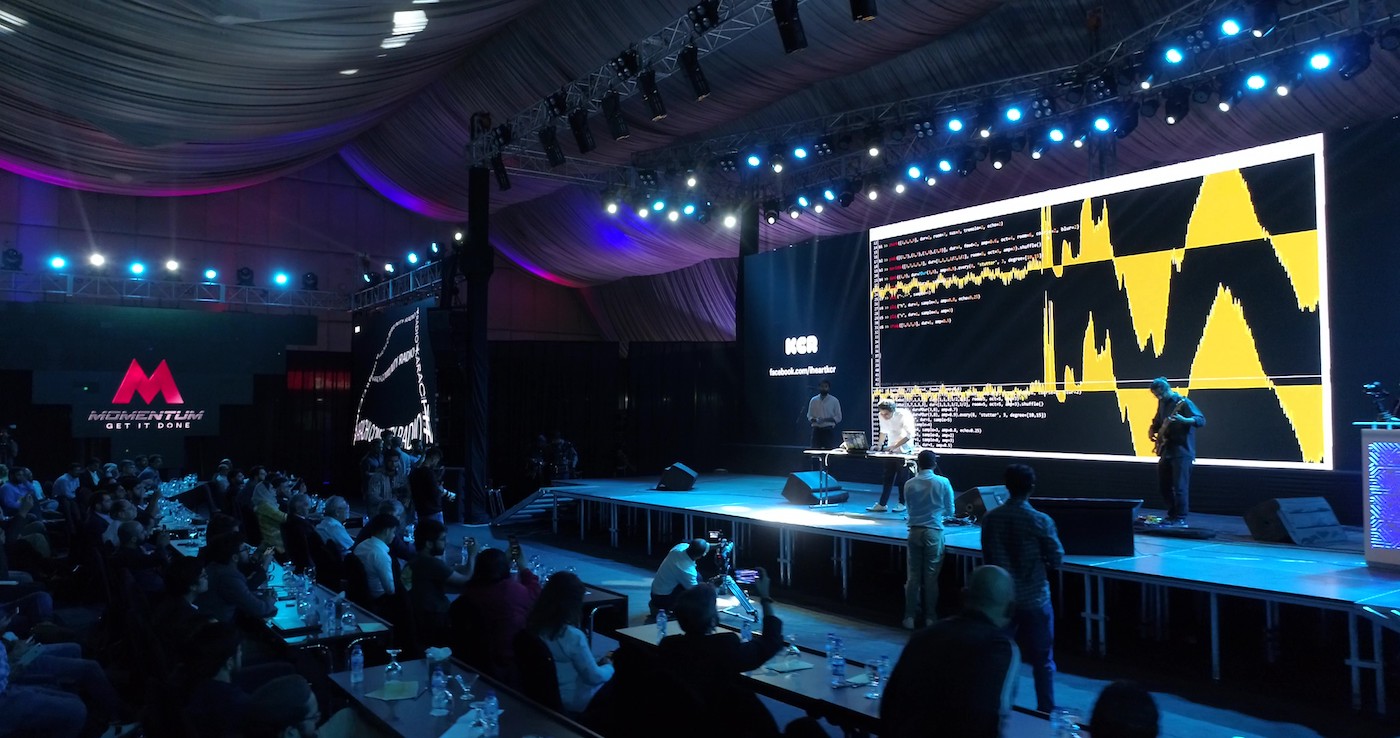 Algorave at Monument Tech Conference 2019 (Karachi, Pakistan)
Algorave at Monument Tech Conference 2019 (Karachi, Pakistan)
At Soup, an independent volunteer-run music venue in Tokyo, Chiho found the ideal space for her Computer Music Parties. Most Asian clubs are generally not very receptive to the idea of Algorave and I know that first-hand. Back in 2019, I sensed some scepticism and disinterest from a couple of Kolkata programmers whom I’d messaged immediately after the Pune rave. The sounds of computer music, bearing no earthly resemblance to typical dancefloor music, are still only beginning to catch on. And for good reason. Many coders like Safder confided in me that it’s tricky to “engineer the groove” on a Raspberry Pi, as the format is admittedly more suited to constructing rhythm.
Nonetheless, my deep credulous dive into the movement’s sonic history revealed a world of sub-genres loosely titled algo-swing, algo-pop, even a few “toplap bands” - besides the usual electronic genres. The range is impressive when you have Khoparzi collaborating with Bollywood composer Sneha Khanwalkar to render Mile Sur Mera Tumhara in Raag Bhairavi, and Nanditi recreating Hindustani Classical ragas on Sonic Pi, and on the other end of the spectrum, Graham Dunning pairing live-coding systems with his trademark console of recycled objects for a techno set.
It’s a rave-new-world
For a culture on the cusp of adulthood, Algorave’s future clearly holds endless promise and possibilities, particularly in Asia where there’s an academic-economic tendency to pursue computational degrees and careers. This not only creates fertile ground for cultivating an interest in creative coding but also reinforces the DIY approach to music production. Khoparzi thinks it even has the potential to bridge a critical gap between art and science, and motivate future generations to confront how algorithms behind our daily screens are manipulated, and reimagine their possibilities for “good” thereof.
“We can achieve a lot by designing college curricula with more computational components,” Khoparzi, who is likely to offer an elective workshop on creative code at the National Institute of Design, tells me.
Noting a spike in interest at his collaborative showcases with new media artists, Rangga has been hosting a series of digital Algoraves for Indonesian coders during the second wave. “I feel like there is so much potential to gather interdisciplinary practice through this,” he adds, also shedding light on infrastructure gaps like low bandwidth that often leads him to set up in a cafe.
Saladino testifies that technical non-access keeps them from onboarding more artists from sub-urban regions to the movement. “You need an agile computer and decent internet connection to play with others, and to understand the fundamentals of programming, you must keep studying regularly, usually from documentation on the internet,” she says.
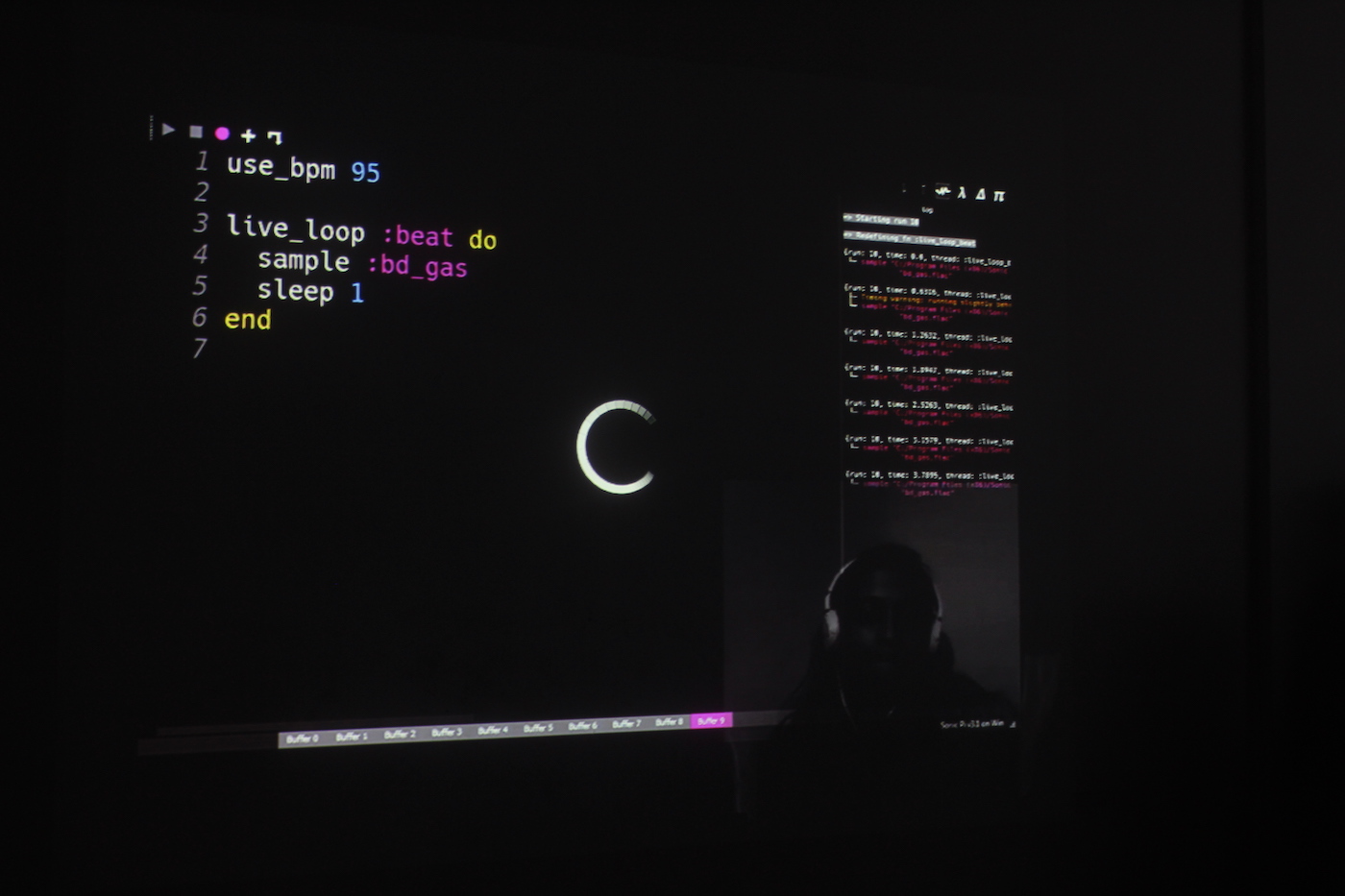 Lag issues during Raia’s remote set at Algorave Pune 2019
Lag issues during Raia’s remote set at Algorave Pune 2019
“With new nodes constantly emerging in the east, we get an opportunity to play with someone from a very different culture which is extremely valuable and edifying,” she writes. Creative coding’s greatest gift, according to her, is this imagination that helps subvert power relations in the real world, through non-utilitarian production and free/Libre/open source (FLOSS) technologies.
Keying into power structures that censor and surveil in South Asia, Murtaza believes that while pro-establishment forums focus on policing traditional artists like Adeela Suleman for their radical ideas, there’s a certain onus on “underground” subcultures to keep the light on.
The common interest then seems to lie not in writing brilliant code, but in creating an alternative environment - a public space where we politically, ethically and aesthetically engage with reality, rethink the world we live in by rethinking the music we make. Many argue that decolonising electronic music starts with its software.
I am reminded of the temporary autonomous zone that writer-activist Michelle Lhooq helped establish during the BLM protests, and later compared to a rave. A TAZ is a no-cop safe space of creating, sharing, healing, and political-partying and algoraves, like TAZes, are a microcosm of a radical future. For it to become a part of mainstream consciousness, we must find new ways of applying these new technologies to solve existing problems. Or as Anushka says, "Fancy algorithms are amazing but not if they cannot be applied.”
Words by Prarthana Mitra
Lead image designed by Sijya Gupta


 Sarah Bahr, Abhinay Khoparzi and Akash Sharma at Algorave 2019 (Pune, India)
Sarah Bahr, Abhinay Khoparzi and Akash Sharma at Algorave 2019 (Pune, India)
 Rangga Purnama with live coder Clarentino Triadi at ARTJOG MMXIX 2019 / Photo by Klitih Bunyi
Rangga Purnama with live coder Clarentino Triadi at ARTJOG MMXIX 2019 / Photo by Klitih Bunyi At Algorave Pune (2019), Sarah Bahr demonstrates how sensors pick up dancers’ movement and feed it to algorithms to interpret and manipulate sound accordingly
At Algorave Pune (2019), Sarah Bahr demonstrates how sensors pick up dancers’ movement and feed it to algorithms to interpret and manipulate sound accordingly Algorave at Monument Tech Conference 2019 (Karachi, Pakistan)
Algorave at Monument Tech Conference 2019 (Karachi, Pakistan) Lag issues during Raia’s remote set at Algorave Pune 2019
Lag issues during Raia’s remote set at Algorave Pune 2019